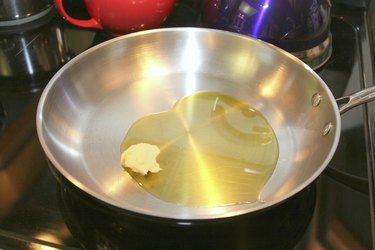
For safety and quality, use use fresh cooking oil each time you fry. However, if you deep-fry large amounts of food frequently, it is not always practical from an economic standpoint. By choosing oils with a high smoke point, preparing food for minimal contamination of the oil and straining the oil to get out any food particles left over, you can reuse most oils as long as they are properly stored.
Bacteria and Free Radicals
Video of the Day
If used oil is not properly strained and stored after it cools, bacteria feeds on food particles left in the oil. Unrefrigerated oil becomes anaerobic and leads to the growth of Clostridium botulinum, which causes botulism, a potentially fatal food poisoning. Refrigerating or freezing oil retards bacterial growth. Rancid -- meaning old and stale -- oil contains free radicals, molecules that can damage cells and lead to increased cancer risk, as well as affect the quality of your food. The good news is that your nose can easily identify rancid oil.
Video of the Day
Smoke Point
The smoke point is the temperature at which oil breaks down and begins to smoke. In general, vegetable oils have higher smoke points than animal fats, and refined oils have higher smoke points than unrefined. Each time you use oil, its smoke point drops. The usual deep-frying temperature is 375 degrees Fahrenheit. If oil has a smoke point just above that, its smoke point will be too low to use again. Refined peanut, soybean and safflower oils have high smoke points at 440, 495 and 510 degrees Fahrenheit, respectively. Extra light olive oil has a high smoke point at 468 degrees Fahrnheit, but is usually more expensive. If well-strained, properly stored and not overheated on first use, these oils should be safe to reuse. However, if you detect any smoke from an oil, discard it.
Using Oil with Reuse in Mind
Keep oil at 375 degrees F when deep-frying to allow breading on food to quickly form a shield to keep food from becoming greasy. A hotter temperature can cause breading to burn and contaminate the oil as well as ruin the food. When preheating, heat only to about 390 degrees Fahrenheit. After breading food, let it rest at room temperature for 15 to 20 minutes before cooking. This gives breading time to dry so it will stick to the food rather than come loose in the oil. Avoid adding salt to food before deep-frying, because salt lowers an oil's smoke point. Once oil smokes, it is no longer safe nor desirable to reuse it.
Storing Oil for Reuse
As soon as oil cools enough to handle, strain through layers of cheesecloth, paper towels or coffee filters to remove food particles. Store in a clean glass jar. Never mix it with unused oil. Seal the jar tightly, label it with the date, and refrigerate or freeze for no longer than a month. It may become cloudy in the refrigerator or freezer, but will clear at room temperature. Never reuse oil if it foamed or changed color during heating, or if it has an odd odor or smells like the food you cooked.